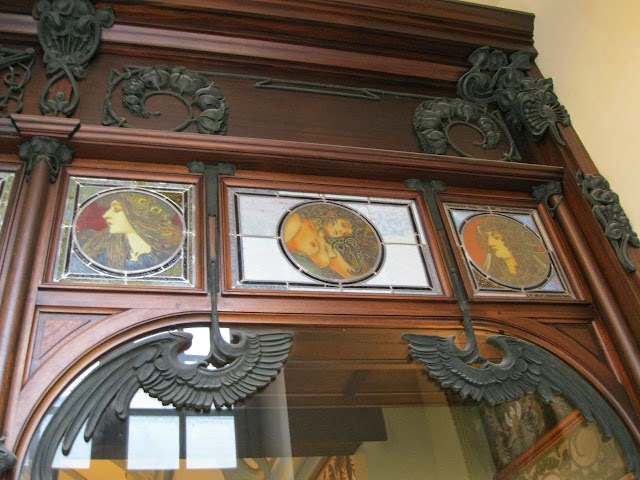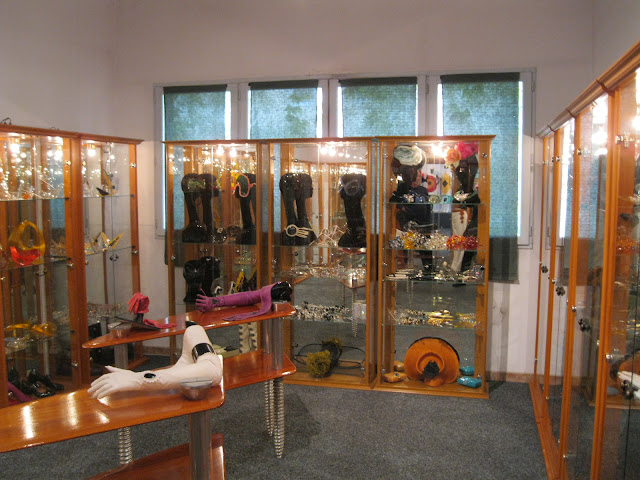We've moved house. Our home for the next 32 days will be at 15 rue des Halles, in the 1st arrondissement.
Rue des Halles is in one of the oldest areas of Paris. Les Halles (The Halls) were the original, central, undercover food markets, but before that, the area was the Cemetery of the Innocents. Do you remember the story (see post No. 22) where the main cemetery of Paris at Les Halles had to be cleared because of disease and contamination, and all of the human remains had to be moved into the Catacombs? Well, yes, its the same place. And anticipating your question, "So, how long after the cemetery was emptied and the incompletely decomposed bodies rendered into tallow and candles, did the food market begin?" That was your question, wasn't it? So I went to the repository of all knowledge and I can now reassure you - it was a year!
And a few years later, when the market was in full swing and the merchants therefore happy, they built a fountain in the very centre of Les Halles and dedicated it to those who had anything but a peaceful final resting place - The Fountain of the Innocents.
And a few years later, when the market was in full swing and the merchants therefore happy, they built a fountain in the very centre of Les Halles and dedicated it to those who had anything but a peaceful final resting place - The Fountain of the Innocents.
Number 15 rue des Halles. Our apartment faces south for the sun, has a tiny balcony with an equally tiny, table and chairs and you can see it there on the second floor to the right, above Le Bistro des Halles and Lapeyre. The balcony is the living room window. The window to the left of it is the dining area and the two windows to the right are the two bedrooms.
It is a very large apartment of 100 square metres, nearly three times as big as our first tiny abode in rue de l'Arbre Sec, in 2011. And it has 4 windows facing south, so if the sun ever shines again, I'll get every drop of it.
It is a very large apartment of 100 square metres, nearly three times as big as our first tiny abode in rue de l'Arbre Sec, in 2011. And it has 4 windows facing south, so if the sun ever shines again, I'll get every drop of it.
But there is always a story to tell, and this is where it happened. This is where I sat silently on the car fridge for more than an hour, playing Free Cell on my iPad, while the men tried to open this door.
Again I anticipate your question, "How did we get ourselves into this position?" Well, let me tell you.
First of all, it is Sunday. Secondly, Paris Visitor Services, the agents from whom we are renting this apartment and from whom we rented in 2011, do not work on Sundays. The arrangment is that you pick up your key from a key safe at a specific secure location and then proceed to your apartment. Good plan. We did that. Paul rode his Velib from rue Bachaumont to the secure key safe at 10am, picked up the key from the safe, secured in an envelope with his name on it, and rode directly to the new apartment buildng, entered the building with the key, went to the correct apartment, rang the bell and, as anticipated, the cleaning lady answered. They agreed that she would be completed by 1.30 pm and we could arrive anytime after that. Paul rode back to rue Bachaumont. We rang the current landlord who agreed to a later departure, arranged a taxi for 1.30pm which arrived on the dot and turned up at rue des Halles at 1.40pm, just as the cleaning lady was leaving the building. She wished us "bon vacance" at the front door and pushed her trolley full of used linen and towels off down the street.
We heaved our two heavy bags (remember, Paul has acquired a dinner jacket and I have an extra pair of shoes plus a bargain-buy 30€ jacket), all of the computer gear which now includes a printer and a reem of paper (Yes I know! but it's hard to work on huge spreadsheets if you can't print), three green Woolworths shopping bags full of pantry/cooking supplies acquired over the past 5 weeks at rue Bachaumont, plus an extremely large car-fridge full of flippers, snorkels, goggles and hand paddles plus the duty free Drambuie and Opal Nera, into the lift and up to the second floor.
But the key doesn't open the door. The nice Asian/Irish/French couple in the next apartment come to assist. "Eet eez not zee correct kee, monsieur! Zay av geev you zee rrong kee! Yo needz wun leek zisss" holding up the type of key that we should have if we ever wish to enter this apartment. At this stage, the two men have spent the best part of twenty minutes putting "zee rrong teep off kee" in the lock and trying to open the door.
Paul rings the Sunday emergency numbers for Paris Visit Services. One number has a message bank, the other has an answering machine, "Please ring again during business hours on Monday. In the meantime, read the instructions in the welcome pack for your apartment, they will explain everything."
Well, sorry, but our problem is not inside the apartment! We haven't got that far yet.
Paul decides to ride back to the building with the key safe to make sure there were no mix-ups with the envelopes containing the keys. The key safe seems intact - no loose keys. On the way out of the key-safe building he runs into the cleaning lady. There are three million people in Paris and he has the luck to run into one of the only two people who can help him. "Ah, madame, I have a problem .....", hey gasps. The lovely lady takes him to a third building, where she gives him the keys she had used when she cleaned our apartment. Paul returns triumphant.
I sit silent on the car fridge playing Free Cell for another 20 minutes while Paul, and then the helpful neighbour, try to open the door. Says the neighbour "Thees eez zee correct type keee but must bee for zee udder apartment, not zees wun. Yoo eez shorr yoo av zee correct apartment?"
Paul is beside himself. I know better than to utter a squeak.
Another door on the landing opens and an old couple in their eighties, or even older, emerge. They ask the problem. The helpful neighbour explains. The old lady marches over to Paul, grabs the keys and fumbles them around the lock with her fingertips - she can't see well. She finally gets the key into the lock and opens the door! She picks up her handbag, hops into the lift and disappears.
We are all silent - especially me.
Paul rings the Sunday emergency numbers for Paris Visit Services. One number has a message bank, the other has an answering machine, "Please ring again during business hours on Monday. In the meantime, read the instructions in the welcome pack for your apartment, they will explain everything."
Well, sorry, but our problem is not inside the apartment! We haven't got that far yet.
Paul decides to ride back to the building with the key safe to make sure there were no mix-ups with the envelopes containing the keys. The key safe seems intact - no loose keys. On the way out of the key-safe building he runs into the cleaning lady. There are three million people in Paris and he has the luck to run into one of the only two people who can help him. "Ah, madame, I have a problem .....", hey gasps. The lovely lady takes him to a third building, where she gives him the keys she had used when she cleaned our apartment. Paul returns triumphant.
I sit silent on the car fridge playing Free Cell for another 20 minutes while Paul, and then the helpful neighbour, try to open the door. Says the neighbour "Thees eez zee correct type keee but must bee for zee udder apartment, not zees wun. Yoo eez shorr yoo av zee correct apartment?"
Paul is beside himself. I know better than to utter a squeak.
Another door on the landing opens and an old couple in their eighties, or even older, emerge. They ask the problem. The helpful neighbour explains. The old lady marches over to Paul, grabs the keys and fumbles them around the lock with her fingertips - she can't see well. She finally gets the key into the lock and opens the door! She picks up her handbag, hops into the lift and disappears.
We are all silent - especially me.
So, I guess we can go in then.
It is now Monday morning and the sun has come out! Magic! I've opened all of the windows and run around with my camera to catch some glimpses of an entirely different vision - sunshine. Very soon I'll be sitting at my tiny table here on the balcony, with a coffee and SUNGLASSES!
This huge building site opposite us is part of the most recent redevelopment of Les Halles. This is one of the entry points for the Metro and the RER (commuter express rail). It is being redeveloped to better respond to passenger traffic flow. At the rear are two hotels built in the late seventies, a Citadines and a Novatel. Both look very out of date now and will probably update in the next decade to reflect the new themes of the latest Les Halles.
Looking to the centre right, from our windows.
And looking to our far right, watching a cycle tour go past. The Seine is one block past the buildings at the end of this street.
The living room.
The kitchen.
The dining table, taken over by Paul for his computer.
My desk and printer, set up on a desk and side tables that we shifted from the bedroom.
Looks great, eh? The French love their baths! It only has a hand held shower - which means you can wash the soap off with a hand-held shower after you bath. Not for me - too cold. There is a 'normal' shower in another area.
The long hallway with the laundry in a cupboard at the far end.
Stunning antique Spanish chandelier in the living area.
A few nice touches.
Having finally concluded this saga, I am sitting in the very late afternoon glow, watching people coming home from work, the street cleaners changing the garbage bags, an illegally parked car getting towed away, two police foot patrols, each three abreast, one at each end of the street. And just now - an accordian player serenading me on my balcony.
How lovely is that?



































































